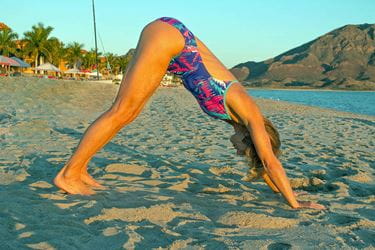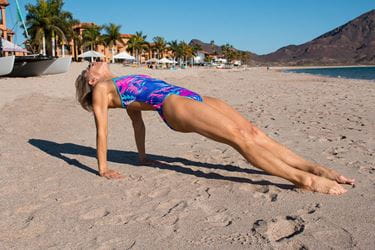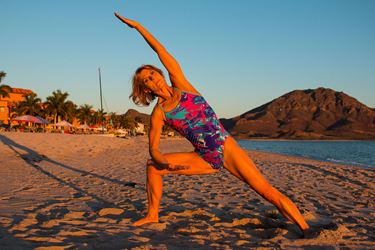Three Yoga Poses for Better Shoulder Health
Try these poses to help your shoulders
Good shoulder range of motion, stability, muscle strength, and flexibility are required for swimming. Yoga postures (asanas) can improve shoulder health and function. Breath (pranayama) should always lead the way when moving into and holding the postures. Breathe long and slow and smooth. Pay attention to the subtleties of the breath and feel what’s happening in your body rather than dwelling on outside worries. This will facilitate a more relaxing and rejuvenating experience.
The Downward-Facing Dog, Upward Plank, and Extended Side Angle poses all work in different ways to benefit shoulder health for the swimmer. Perform these asanas after your muscles are warmed up. Once you find your comfortable expression of the pose, remain there for five to 10 slow breaths.
Downward-Facing Dog (Adho Mukha Svanasana)
Benefits
The Downward-Facing Dog pose benefits swimmers in two major ways. Firstly, it improves movement in the shoulder joint and enhances flexibility of the muscles around the shoulder girdle, including the latissimus dorsi, pectoralis minor, rhomboids, posterior deltoids, and teres major, improving upper postural alignment and streamline position.
girdle, including the latissimus dorsi, pectoralis minor, rhomboids, posterior deltoids, and teres major, improving upper postural alignment and streamline position.
A slumped posture—common in swimmers and computer users—makes it difficult to do overhead movements without creating undue compressive forces inside the shoulder complex. This can eventually lead to impingement syndrome and resultant tendinitis.
Secondly, the weight-bearing action of Downward-Facing Dog pose strengthens muscles in the triceps, spine, and shoulder girdle. The load borne by the shoulder, upper back, and four rotator cuff muscles will lead to improved stability of the shoulder joint when it’s under duress. The shoulder joint tends to be unstable and needs a proper balance of strength to keep the head of the humerus (arm bone) centered in the glenohumeral joint socket. Strong shoulder-girdle muscles can help improve shoulder stability and function, enabling a swimmer to increase stroke tempo or distance with less potential for injury.
How to Execute
While standing, bend forward at the waist and bend your knees enough that your hands can touch the mat. Walk your feet away from your hands until they are a few feet apart and raise your sit bones skyward. Your hands should be positioned shoulder-width apart (fingers spread), and your feet should be positioned about hip-width apart. Gently start to press your chest back toward your thighs and your heels toward the floor, keeping your hips high and your neck relaxed (so the crown of your head and the back of your neck feel like they’re lengthening toward the floor).
It’s important to externally rotate your shoulders so that your teres minor and infraspinatus (two of the four rotator cuff muscles) are active. Depress your shoulders toward your waist instead of letting them shrug toward your ears. Avoid locking your elbows and knees, keeping the strength in the supporting muscles. Engage your thigh muscles (quadriceps). Lengthen your spine from your sacrum (at the base) to the crown of your head. Swimmers with wrist problems can modify this pose by supporting themselves on their forearms, rather than their hands, in a modified pose known as the dolphin.
Upward Plank or Reverse Table Top (Purvottanasana)
Benefits
The Upward Plank builds upper postural muscle strength and lengthens the internal rotators and the muscles in the front of the chest and shoulder area (pectoralis major and minor, anterior deltoids, and subscapularis). By lengthening muscles that tend to shorten and tighten, optimal posture is restored and there is less potential for impingement and overuse injury. Bearing the body weight in this position involves scapular downward rotation, elevation and adduction, and shoulder and elbow extension.
anterior deltoids, and subscapularis). By lengthening muscles that tend to shorten and tighten, optimal posture is restored and there is less potential for impingement and overuse injury. Bearing the body weight in this position involves scapular downward rotation, elevation and adduction, and shoulder and elbow extension.
This pose strengthens the triceps, muscles along the back and side of the neck (levator scapulae), the strips of muscles at the bases of the arm pits (teres major), rotator cuff muscles, and the back of the shoulders, facilitating more shoulder stability. The beauty of this pose is that it’s weight bearing in a pectoral muscle and heart-center opening position, which improves shoulder function by making more space in the front of the shoulder and strengthening the muscles most important for shoulder stability.
How to Execute
Sit on a mat with your legs extended. Place your hands about a foot behind your hips, fingers pointing toward your buttocks, hands slightly wider than shoulder-width apart. Bend your knees and place your feet flat on the floor, hip-width apart. Press the inner sides of your feet and hands down as you slowly raise your hips up toward the sky into reverse table top pose, with your thighs nearly parallel to the ground and head back and in alignment with the rest of your spine, opening the sides of your shoulders. Without lowering your hips, extend one leg at a time, placing the flat of your foot on the mat. Your wrists should be directly under your shoulders. Your hamstrings should do the most work to keep your hips in extension.
If your glutes are working too hard and you feel lower back discomfort, revert to reverse table top pose. In this simplified version of the posture, your ankles are positioned directly under your knees and your knees are tracking in the same direction as the toes.
Extended Side Angle (Utthita Parsvakonasana)
Benefits
Utthita Parsvakonasana lengthens many muscles supporting the shoulder girdle which tend to be overly shortened in swimmers. This common muscle tension imbalance can lead to improper positioning of the humerus in the shallow concave of the glenohumeral joint socket. When the arm bone is properly seated, there is a balance of strength and tension in surrounding muscles, which facilitates healthy movement. Even post-injury (after a reasonable recovery period), you may be able to move pain-free when your muscles are properly balanced. This pose may help swimmers achieve a tighter streamline off of their walls and reduce the risk of impingement, tendinitis, and rotator cuff injuries.
improper positioning of the humerus in the shallow concave of the glenohumeral joint socket. When the arm bone is properly seated, there is a balance of strength and tension in surrounding muscles, which facilitates healthy movement. Even post-injury (after a reasonable recovery period), you may be able to move pain-free when your muscles are properly balanced. This pose may help swimmers achieve a tighter streamline off of their walls and reduce the risk of impingement, tendinitis, and rotator cuff injuries.
How to Execute
Adopt a wide stance on a mat with your right foot turned toward the front of the mat and your left foot turned at about a 45-degree angle toward the front. Hold your arms out to your sides like tree branches. Lunge forward, bending your right leg until your knee is stacked over your right ankle. Perch your right forearm on your right thigh, without dumping too much weight into it (so there’s space between your shoulder and ear). Spiral the left side of your body upward, extending your left arm over your head and beyond so that you feel a strong stretch in the left side of your body from the triceps to the waist. Ground in all four corners of each foot. Hold the pose and then switch sides.
Categories:
- Technique and Training
















